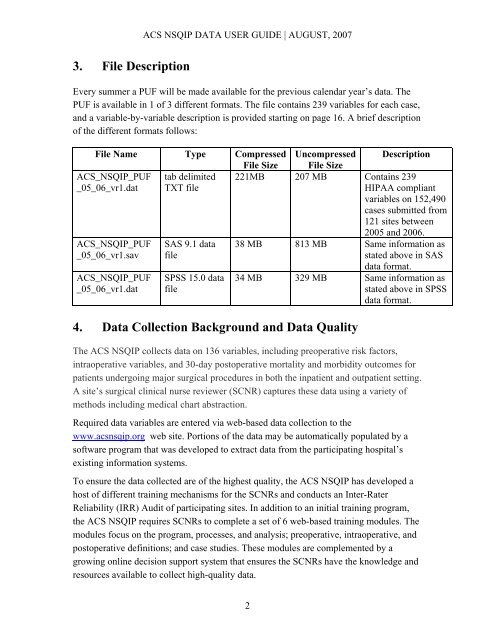User Guide for the Participant Use Data File - ACS NSQIP
User Guide for the Participant Use Data File - ACS NSQIP
User Guide for the Participant Use Data File - ACS NSQIP
Create successful ePaper yourself
Turn your PDF publications into a flip-book with our unique Google optimized e-Paper software.
3. <strong>File</strong> Description<br />
<strong>ACS</strong> <strong>NSQIP</strong> DATA USER GUIDE | AUGUST, 2007<br />
Every summer a PUF will be made available <strong>for</strong> <strong>the</strong> previous calendar year’s data. The<br />
PUF is available in 1 of 3 different <strong>for</strong>mats. The file contains 239 variables <strong>for</strong> each case,<br />
and a variable-by-variable description is provided starting on page 16. A brief description<br />
of <strong>the</strong> different <strong>for</strong>mats follows:<br />
<strong>File</strong> Name Type Compressed Uncompressed Description<br />
<strong>File</strong> Size <strong>File</strong> Size<br />
<strong>ACS</strong>_<strong>NSQIP</strong>_PUF tab delimited 221MB 207 MB Contains 239<br />
_05_06_vr1.dat TXT file<br />
HIPAA compliant<br />
variables on 152,490<br />
cases submitted from<br />
121 sites between<br />
2005 and 2006.<br />
<strong>ACS</strong>_<strong>NSQIP</strong>_PUF SAS 9.1 data 38 MB 813 MB Same in<strong>for</strong>mation as<br />
_05_06_vr1.sav file<br />
stated above in SAS<br />
data <strong>for</strong>mat.<br />
<strong>ACS</strong>_<strong>NSQIP</strong>_PUF SPSS 15.0 data 34 MB 329 MB Same in<strong>for</strong>mation as<br />
_05_06_vr1.dat file<br />
stated above in SPSS<br />
data <strong>for</strong>mat.<br />
4. <strong>Data</strong> Collection Background and <strong>Data</strong> Quality<br />
The <strong>ACS</strong> <strong>NSQIP</strong> collects data on 136 variables, including preoperative risk factors,<br />
intraoperative variables, and 30-day postoperative mortality and morbidity outcomes <strong>for</strong><br />
patients undergoing major surgical procedures in both <strong>the</strong> inpatient and outpatient setting.<br />
A site’s surgical clinical nurse reviewer (SCNR) captures <strong>the</strong>se data using a variety of<br />
methods including medical chart abstraction.<br />
Required data variables are entered via web-based data collection to <strong>the</strong><br />
www.acsnsqip.org web site. Portions of <strong>the</strong> data may be automatically populated by a<br />
software program that was developed to extract data from <strong>the</strong> participating hospital’s<br />
existing in<strong>for</strong>mation systems.<br />
To ensure <strong>the</strong> data collected are of <strong>the</strong> highest quality, <strong>the</strong> <strong>ACS</strong> <strong>NSQIP</strong> has developed a<br />
host of different training mechanisms <strong>for</strong> <strong>the</strong> SCNRs and conducts an Inter-Rater<br />
Reliability (IRR) Audit of participating sites. In addition to an initial training program,<br />
<strong>the</strong> <strong>ACS</strong> <strong>NSQIP</strong> requires SCNRs to complete a set of 6 web-based training modules. The<br />
modules focus on <strong>the</strong> program, processes, and analysis; preoperative, intraoperative, and<br />
postoperative definitions; and case studies. These modules are complemented by a<br />
growing online decision support system that ensures <strong>the</strong> SCNRs have <strong>the</strong> knowledge and<br />
resources available to collect high-quality data.<br />
2


